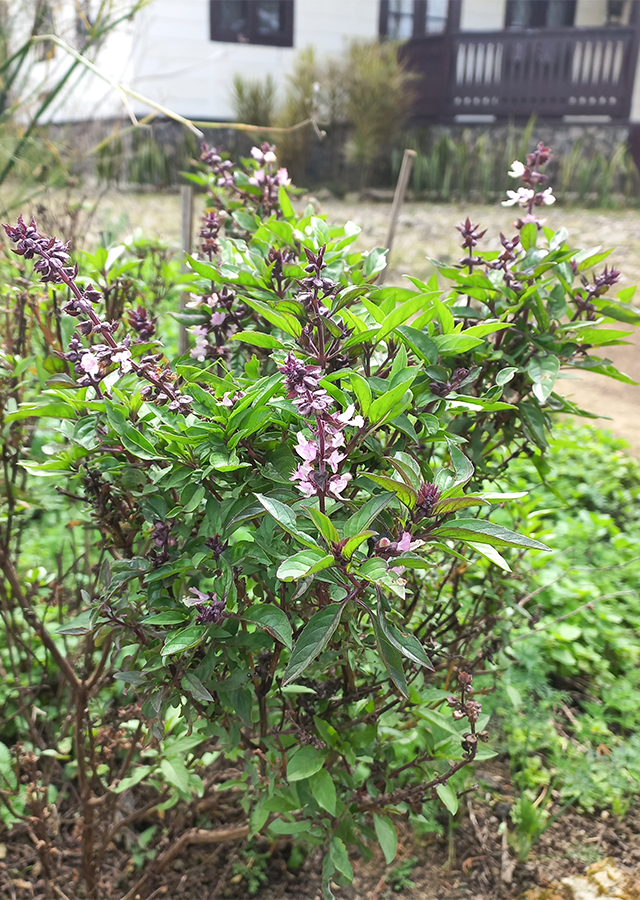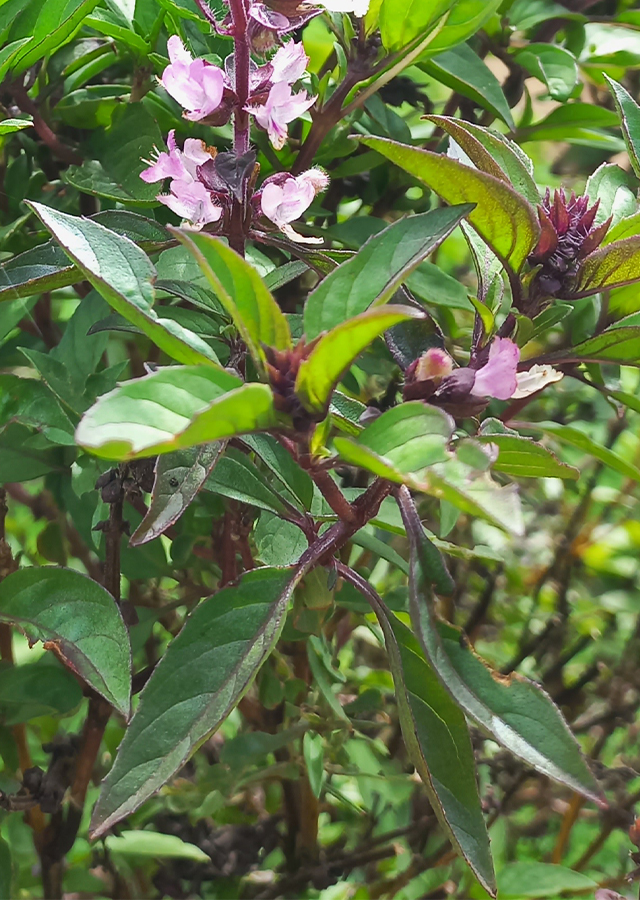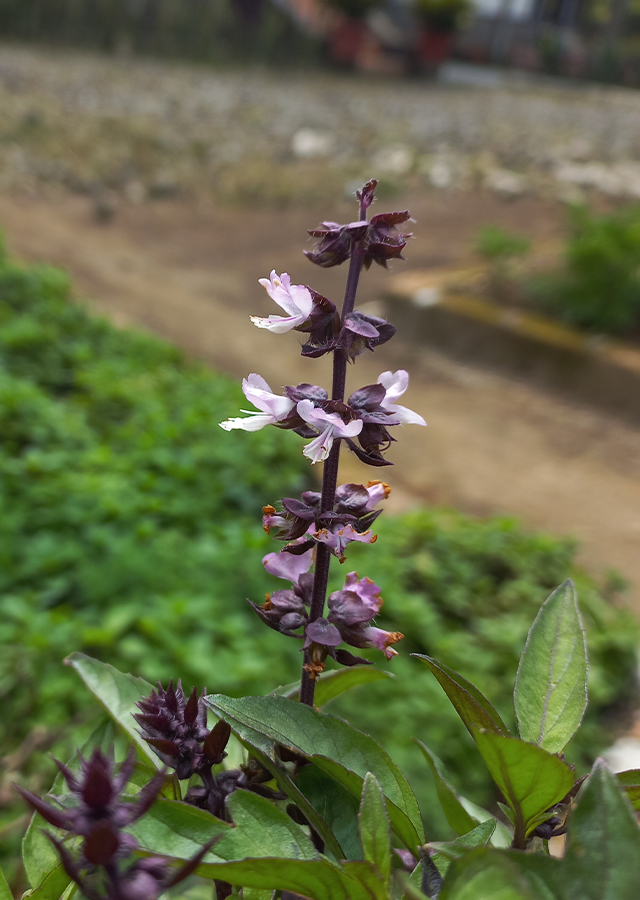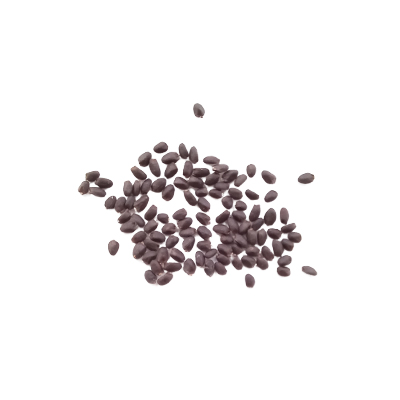Thai Basil
Ocimum basilicum var. thyrsiflorum (L.) Benth.
Lamiaceae
Location in our garden
Vegetable



Synonym
-
Habitus
Herbaceous. A vigorous perennial herbaceous plant that grows 30-60 cm tall.
Part Used
Leaves
Seeds
Flowers
Growing Requirements
Full Sunshine
Habitat
Terrestrial
Overview
Ocimum basilicum var. basilicum is native to South-East Asia. It is prized for its culinary use, ornamental qualities, and health benefits which is why it has been used in traditional healing since centuries ago. Thai Basil is a popular herb for use in Thai, Vietnamese, Laotian and Cambodian cuisines. The leaves are often stir-fried with meat or added to Vietnamese beef soup (known as 'pho'). It contains a great source of vitamins and vital nutrients such as vitamin C and omega-3 fatty acid, iron, calcium, magnesium, and potassium.
Vernacular Names
Káu-chàn-thah (Taiwanese).
Agroecology
The plant grows best in a sunny location with fertile, well-drained soil that is allowed to dry slightly before re-watering. Avoid getting the leaves wet when you water. You don’t have to worry about leaving it out in the summer heat, and during the winter, all you have to do is put it under a grow light. As long as you keep your Thai Basil nice and warm (18-21 °C), give it just enough water, and make sure to pinch the tip of the branches, Thai Basil can also be grown indoors near a sunny window if it receives at least 6 hours of sunlight each day.
Morphology
- Stem - is square in cross-section. When the plant matures, spikes of lavender to dark-violet flowers grow at the tops of the reddish-purple stems.
- Leaves - aromatic, shiny leaves often have purple veins. The narrow, bright-green leaves have serrated edges and are typically smaller and sturdier than those of common sweet basil. They also boast a fresh and spicy fragrance and sometimes have a slight purple tint, 2.5-5 cm long.
- Flower - bisexual, purple-pink. The inflorescences are densely branched and with loose verticil.
Cultivation
- Generative propagation is by seed.
- Vegetative propagation is by stem cutting - cut about 10 cm stem right below a node and remove all of the basil leaves on the bottom (about 5 cm from the end of the stem).
Chemical Constituents
Flavonoids (vicenin, and orientin), sequiterpenoids, diterpene alcohol, fatty methyl esters (linoleic acid, gamma linoleic acid, arachidonic acid), essential oils (methyl chavicol, β-(E)-oci-mene, and α-(E)-bergamotene), anthraquinones and tannins.
Traditional Medicinal Uses
- Leaves and seeds have antioxidant, antiviral, antifungal, anti-bacterial and anti-inflammatory properties.
- It is used to treats cough, fever, and cold.
- It prevents cancer, relieve stress, and also improves digestion.
Part Used
Reference Sources
- Fabian, Danah. (2021). The Benefits Of Thai Basil, And Why You Should Be Growing Thai Basil Indoors. https://www.geturbanleaf.com/blogs/herbs/the-benefits-of-thai-basil-and-why-you-should-be-growing-thai-basil-indoors#:~:text=Research%20shows%20that%20Thai%20Basil,its%20aroma%20to%20relieve%20stress. 22-09-2022.
- Gardenia. (No date). Ocimum basilicum 'Siam Queen' (Thai Basil). https://www.gardenia.net/plant/ocimum-basilicum-siam-queen. 22-09-2022.
- Kew Royal Botanic Gardens. (No date). Plants of the World Online: Ocimum basilicum var. basilicum. https://powo.science.kew.org/taxon/urn:lsid:ipni.org:names:77233860-1. 22-09-2022.
- Naidu, J. R., Sasidharan, J. R., and Ismail, R. B. (2016). Chemical Profiling and Antioxidant Activity of Thai Basil ( Ocinum basilicum ). Journal of essential oil-bearing plants JEOP, 19(3):750-755. DOI:10.1080/0972060X.2013.793989. Also available: https://www.researchgate.net/publication/303531643_Chemical_Profiling_and_Antioxidant_Activity_of_Thai_Basil_Ocimum_basilicum.
- National Park of Singapore. (2021). Flora & Fauna Web: Ocimum basilicum (Thai basil). https://www.nparks.gov.sg/florafaunaweb/flora/6/6/6695. 22-09-2022.
- Pardee, Pearl. (2017). Health Benefits of Thai Basil. https://www.thaispices.com/blog/health-benefits-thai-basil/. 22-09-2022.
- Pripdeevech, P., Chumpolsri, W., Suttiarporn, P., and Wongpornchai, S. (2010). The chemical composition and antioxidant activities of basil from Thailand using retention indices and comprehensive two-dimensional gas chromatography. Journal of the Serbian Chemical Society. 75 (11): 1503–1513.
- Sain, Renu. (2021). Amazing Health Benefits of Thai Basil. https://www.timesfoodie.com/nutritional-facts/amazing-health-benefits-of-thai-basil/87803620.cms. 22-09-2022.



